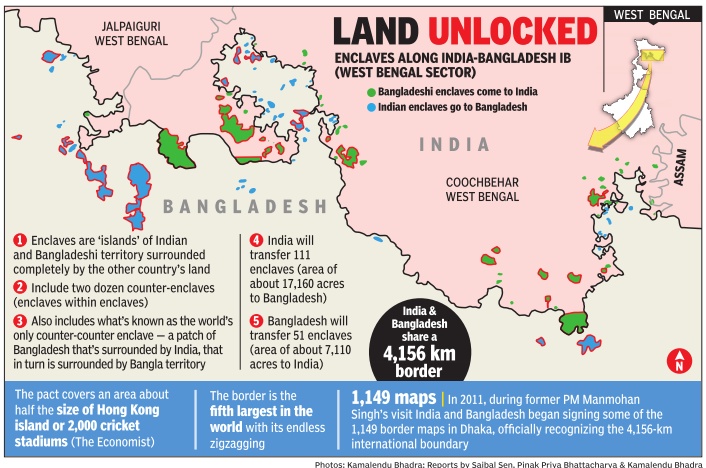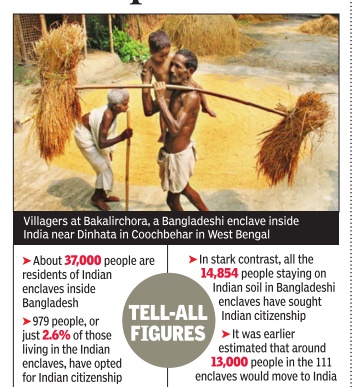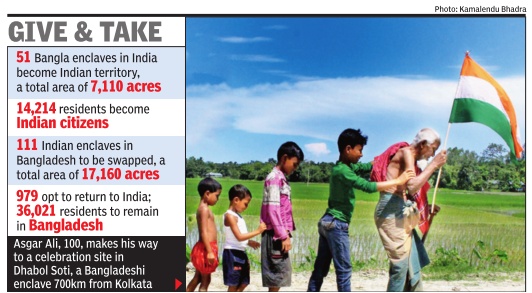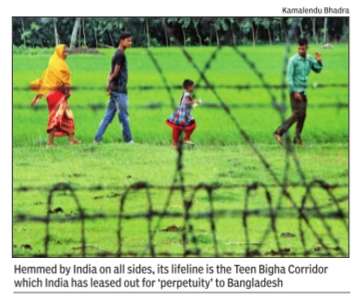India- Bangladesh enclaves
(→2015: Freedom from uncertain belongingness) |
|||
| Line 66: | Line 66: | ||
At the stroke of midnight, 14,214 citizens of Bangladesh, who had been residing in 51 enclaves within India, became Indians. It's an independence that has come late, but arrived nonetheless. | At the stroke of midnight, 14,214 citizens of Bangladesh, who had been residing in 51 enclaves within India, became Indians. It's an independence that has come late, but arrived nonetheless. | ||
The tricolour was unfurled in these enclaves, at half-mast because India is mourning former President APJ Abdul Ka lam. At the same time, 111 Indian enclaves in Bangladesh merged with that country . Of the 37,000 living there, 979 have opted to move to India, allaying fears of a huge transfer of population when the historic Land Boundary Agreement became operative and both countries redrew their boundary maps along north Bengal.No one from the Bangladeshi enclaves in India has chosen to cross over. The total number of new Indian citizens will be 15,193. The swap will be completed by November 2015. | The tricolour was unfurled in these enclaves, at half-mast because India is mourning former President APJ Abdul Ka lam. At the same time, 111 Indian enclaves in Bangladesh merged with that country . Of the 37,000 living there, 979 have opted to move to India, allaying fears of a huge transfer of population when the historic Land Boundary Agreement became operative and both countries redrew their boundary maps along north Bengal.No one from the Bangladeshi enclaves in India has chosen to cross over. The total number of new Indian citizens will be 15,193. The swap will be completed by November 2015. | ||
| + | |||
| + | =Dahagram-Angorpota= | ||
| + | [http://epaperbeta.timesofindia.com/Article.aspx?eid=31808&articlexml=Kept-out-of-land-deal-Bangla-enclave-is-02082015019005 ''The Times of India''], Aug 02 2015 | ||
| + | [[File: Teen Bigha Corridor.jpg|Graphic courtesy: [http://epaperbeta.timesofindia.com/Article.aspx?eid=31808&articlexml=Kept-out-of-land-deal-Bangla-enclave-is-02082015019005 ''The Times of India''], Aug 02 2015|frame|500px]] | ||
| + | |||
| + | Kept out of land deal, Bangla enclave is a chicken's neck | ||
| + | |||
| + | Saibal Sen & Pinak Priya Bhattacharya | ||
| + | |||
| + | ''' '' Teen Bigha: '' ''' | ||
| + | |||
| + | ''' Fate sealed in 1974, no relief in sight ''' | ||
| + | |||
| + | At the stroke of the midnight, India's 4096.7km boundary with Bangladesh was redrawn. A 68-yearold “aberration“ 51 Bangladeshi enclaves in India and 111 Indian enclaves in Bangladesh -was rectified. But with one exception. | ||
| + | A 4616.85 acre Bangladeshi land, inhabited by 3,165 families, firmly perched on India. Dahagram-Angorpota, a Bangladeshi enclave, remained out of the Indo-Bangladesh agreement signed by PM Narendra Modi and his Bangaldeshi counterpart Sheikh Hasina on June 6, 2015. Its history was written 23 years back, on June 26, 1992. | ||
| + | |||
| + | Dahagram-Angorpota is a chicken's neck. Hemmed by India on all sides, its lifeline is a five-minute walking stretch -the Teen Bigha Corridor -which India has leased out for “perpetuity“ to Bangladesh. The Teen Bigha Corridor (literally meaning three bighas of Indian land) connects Dahagram-Angorpota to Bangladesh's Lalmonirhat district and Patgram police station area. | ||
| + | |||
| + | The 1974 Land Boundary Agreement signed by Indira Gandhi and Sheikh Mujibur Rehman provided that India would retain half of Berubari Union No. 12 and in exchange Bangladesh would retain the Dahagram and Angorpota enclaves. The agreement further provided that India would lease in perpetuity to Bangladesh the Teen Bigha Corridor for the purpose of connecting Dahagram-Angorpota to Bangladesh. | ||
| + | |||
| + | This part of 1974 pact was implemented on June 26, 1992. This was done through exchange of letters on March 26, 1992. Therefore, this didn't fall under the ambit of the latest Indo-Bangladesh accord. | ||
| + | |||
| + | Utpal Ray, president of Kuchlibari Sangram Committee, said, “We had hoped that something will be done about the Dahagram-Angorpota. If enclaves are being considered an aberration, why retain one. DahagramAngorpota's 7.15 square miles boundary with India isn't fenced. The estimated 34,000 people living there will be best served if they become a part of India. Moreover, unrestricted access makes it a criminal haven.“ | ||
| + | |||
| + | He added that representations in this regard were made to the senior NDA leadership, including external affairs minister Sushma Swaraj and home minister Rajnath Singh. “Even Bengal CM Mamata Banerjee had promised to consider the matter. Darjeeling MP S S Ahluwalia has already raised the matter in Parliament. We are not giving up hope,“ said Ray . | ||
| + | |||
| + | For an international treaty already signed, the demand for a rollback appears far-fetched. | ||
| + | |||
| + | Biswabar Ray (45), a state employee, said, “It has really left us trapped. If Bangladesh chooses to fence the Teen Bigha corridor, we will have no links with mainland India.“ | ||
| + | |||
| + | Md Monirul Islam, a small-time trader, said, “Apart from connectivity , we will face other infrastructural woes. Take for example my village, Kalshigram. It has 390 voters, but for 68 years electricity hasn't yet reached us.“ | ||
| + | |||
| + | Bikash Ray, employee in a private telecom company , said, “In their effort to woo Bangladesh, India can't deny the legitimate rights of its own citizens. The Teen Bigha corridor, earlier, had some movement restrictions. Now it's kept open day and night.It is choking us. Incidents of cattle smuggling are increasing. There's no security .Isn't this enough for the government to pay heed to our complaints?“ | ||
| + | |||
| + | ''' Pilot corridor for cargo movement soon ''' | ||
| + | |||
| + | India and Bangladesh will soon identify a corridor as pilot for direct movement of cargo between the two countries. Both sides are scheduled to meet in September to identify the route and sources said this would be between a point in West Bengal and Bangladesh.Sources said the route will be suggested by Bengal and Bangladesh during this meeting. | ||
| + | |||
| + | This plan under Bangladesh, Bhutan, India and Nepal (BBIN) agreement for movement of all types of vehicles aims at seamless transport of cargo and passenger vehicles in the region. “At present, the cargo coming from either side is transferred at the border to vehicles plying in that particular country,“ an official said. He added the success of this pilot will also mean that a vehicle carrying cargo from Bangladesh can reach Nepal directly using Indian roads. | ||
Revision as of 19:33, 2 August 2015



This is a collection of articles archived for the excellence of their content. |
Contents |
In brief
The Times of India, Aug 01 2015
What's an enclave?
A patch of land encircled by another country's territory. India had 111 such enclaves within Bangladesh, which in turn has 51 of its enclaves within India. These enclaves dotted the Indo-Bangla land boundary in north Bengal and date back to 18th century when they were part of the Coochbehar and Rangpur princely states which merged with India and Pakistan respectively . Indian enclaves were spread over Panchagarh, Lalmonirhat, Kurigram and Nilphamari districts of Bangladesh. All Bangladeshi enclaves were situated in Coochbehar. With the merger of the princely states with India and Pakistan not changing the status of these enclaves, the people living in them did not enjoy full legal rights as citizens of either country . The areas lacked even basic infrastructure facilities such as electricity and schools, and health services were deficient. Some later became a hot bed of criminal activities.
How many people reside in these enclaves?
A joint headcount conducted in 2011 determined the population in the enclaves to be around 51,549 (37,334 in Indian enclaves and 14,215 in the ones in Bang ladesh). The total area covered by the 111 Indian en covered by the 111 Indian enclaves in Bangladesh is 17160.63 acres and the 51 Bangladesh enclaves in India is 7110.02 acres.
Will the new border alignment lead to a huge transfer of population?
So far not a single household living in the Indian enclave in Bangladesh has opted to move to Bangladesh. But 979 people living in the Bangladesh enclaves in India have opted to shift to Indian territory.
What are the problems in the Land Boundary Agreement?
People coming into India from Bangladeshi enclaves won't be given citizenship immediately . They must wait till November for formalities to be completed and are likely to face problems arising out of lack of state-backed residency proof and identity documents.
How the enclaves were formed
The Times of IndiaJun 01 2015
Jayanta Gupta & Pinak Priya Bhattacharya
These enclaves were part of the former Cooch Behar kingdom, which ceded pockets of territory to the Mughals and the British. When Cooch Behar acceded to India, parts of it which were in Bangladesh (then East Pakistan), naturally became part of India, except for the small technicality of them lying in another country . For decades, residents of the enclaves have lived in isolation in a sense: A Bangladeshi enclave, surrounded by India, is cut off from facilities and benefits from its own country . The same happens to Indians marooned in Bangladeshi territory . The constitutional amendment essentially allows the countries to swap land so that those living in the enclaves can get citizenship rights without having to move out of their traditional homes if they do not wish to. It will also settle the decades-old border disorder.
Low turnout for Indian citizenship in enclaves

The Times of India, Jul 25 2015
Debasish Konar
Jamaat role seen as just 979 from enclaves opt for India
Not many yes for Indian citizenship from the 37,000-odd people staying in Indian enclaves inside Bangladesh has raised the suspicion of a Jamaat-e-Islami hand in ensuring a very low turnout. Just 979 people, or about 2.6% of those living in the Indian enclaves, have opted for Indian citizenship. In stark contrast, all the 14,854 staying on Indian soil in Bangladeshi enclaves have sought Indian citizenship. A home department official said there were allegations that Jamaat had prevented Indian enclave-dwellers from freely exercising their option. The home ministry has been alerted on this, he added.
The numbers have even surprised officials as the Centre has assured a kitty of Rs 3,000 crore for rehabilitation of the people who shift from the Indian enclaves in Bangladesh. It was earlier estimated that around 13,000 people in the 111 enclaves would move to India.
Cooch Behar Trinamool Congress MP Renuka Sinha confirmed the development.She said several thousand Indians living in Indian enclaves in Bangladesh had not been able to express their option freely as they had been intimidated by Jamaat activists. “I have written to Union home minister Rajnath Singh and external affairs minister Sushma Swaraj. Those who wanted to opt for India were not allowed to do so. Jamaat activists put their thumb impressions on the option papers and stated Bangladesh as their choice,“ she alleged. Many enclave-dwellers working in different parts of India have complained to the district magistrate of Cooch Behar to make their option as they were intimidated, said Debabrata Chaki of the Indian Enclaves United Council. He said even people with land deeds were prohibited from exercising their option.
2015: Freedom from uncertain belongingness
The Times of India, Aug 01 2015

Saibal Sen & Pinak Priya Bhattacharya
Moshaldanga (West Bengal)
Bangladesh, India in historic enclave swap
At the stroke of midnight, 14,214 citizens of Bangladesh, who had been residing in 51 enclaves within India, became Indians. It's an independence that has come late, but arrived nonetheless. The tricolour was unfurled in these enclaves, at half-mast because India is mourning former President APJ Abdul Ka lam. At the same time, 111 Indian enclaves in Bangladesh merged with that country . Of the 37,000 living there, 979 have opted to move to India, allaying fears of a huge transfer of population when the historic Land Boundary Agreement became operative and both countries redrew their boundary maps along north Bengal.No one from the Bangladeshi enclaves in India has chosen to cross over. The total number of new Indian citizens will be 15,193. The swap will be completed by November 2015.
Dahagram-Angorpota
The Times of India, Aug 02 2015

Kept out of land deal, Bangla enclave is a chicken's neck
Saibal Sen & Pinak Priya Bhattacharya
Teen Bigha:
Fate sealed in 1974, no relief in sight
At the stroke of the midnight, India's 4096.7km boundary with Bangladesh was redrawn. A 68-yearold “aberration“ 51 Bangladeshi enclaves in India and 111 Indian enclaves in Bangladesh -was rectified. But with one exception. A 4616.85 acre Bangladeshi land, inhabited by 3,165 families, firmly perched on India. Dahagram-Angorpota, a Bangladeshi enclave, remained out of the Indo-Bangladesh agreement signed by PM Narendra Modi and his Bangaldeshi counterpart Sheikh Hasina on June 6, 2015. Its history was written 23 years back, on June 26, 1992.
Dahagram-Angorpota is a chicken's neck. Hemmed by India on all sides, its lifeline is a five-minute walking stretch -the Teen Bigha Corridor -which India has leased out for “perpetuity“ to Bangladesh. The Teen Bigha Corridor (literally meaning three bighas of Indian land) connects Dahagram-Angorpota to Bangladesh's Lalmonirhat district and Patgram police station area.
The 1974 Land Boundary Agreement signed by Indira Gandhi and Sheikh Mujibur Rehman provided that India would retain half of Berubari Union No. 12 and in exchange Bangladesh would retain the Dahagram and Angorpota enclaves. The agreement further provided that India would lease in perpetuity to Bangladesh the Teen Bigha Corridor for the purpose of connecting Dahagram-Angorpota to Bangladesh.
This part of 1974 pact was implemented on June 26, 1992. This was done through exchange of letters on March 26, 1992. Therefore, this didn't fall under the ambit of the latest Indo-Bangladesh accord.
Utpal Ray, president of Kuchlibari Sangram Committee, said, “We had hoped that something will be done about the Dahagram-Angorpota. If enclaves are being considered an aberration, why retain one. DahagramAngorpota's 7.15 square miles boundary with India isn't fenced. The estimated 34,000 people living there will be best served if they become a part of India. Moreover, unrestricted access makes it a criminal haven.“
He added that representations in this regard were made to the senior NDA leadership, including external affairs minister Sushma Swaraj and home minister Rajnath Singh. “Even Bengal CM Mamata Banerjee had promised to consider the matter. Darjeeling MP S S Ahluwalia has already raised the matter in Parliament. We are not giving up hope,“ said Ray .
For an international treaty already signed, the demand for a rollback appears far-fetched.
Biswabar Ray (45), a state employee, said, “It has really left us trapped. If Bangladesh chooses to fence the Teen Bigha corridor, we will have no links with mainland India.“
Md Monirul Islam, a small-time trader, said, “Apart from connectivity , we will face other infrastructural woes. Take for example my village, Kalshigram. It has 390 voters, but for 68 years electricity hasn't yet reached us.“
Bikash Ray, employee in a private telecom company , said, “In their effort to woo Bangladesh, India can't deny the legitimate rights of its own citizens. The Teen Bigha corridor, earlier, had some movement restrictions. Now it's kept open day and night.It is choking us. Incidents of cattle smuggling are increasing. There's no security .Isn't this enough for the government to pay heed to our complaints?“
Pilot corridor for cargo movement soon
India and Bangladesh will soon identify a corridor as pilot for direct movement of cargo between the two countries. Both sides are scheduled to meet in September to identify the route and sources said this would be between a point in West Bengal and Bangladesh.Sources said the route will be suggested by Bengal and Bangladesh during this meeting.
This plan under Bangladesh, Bhutan, India and Nepal (BBIN) agreement for movement of all types of vehicles aims at seamless transport of cargo and passenger vehicles in the region. “At present, the cargo coming from either side is transferred at the border to vehicles plying in that particular country,“ an official said. He added the success of this pilot will also mean that a vehicle carrying cargo from Bangladesh can reach Nepal directly using Indian roads.